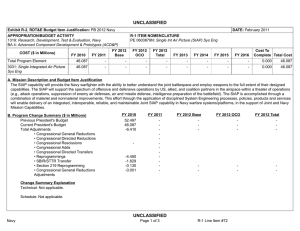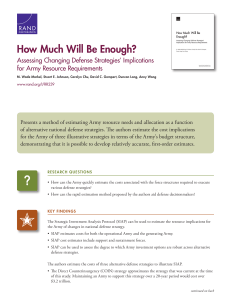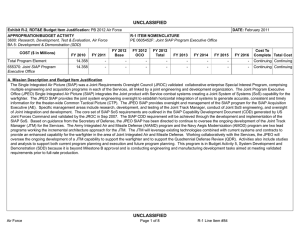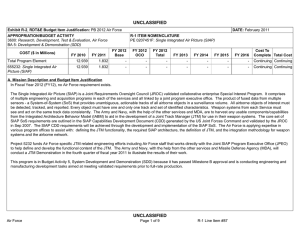Time Use Survey Conducted in China 16-19 April 2013, SIAP,Chiba,Japan Gong Shaojun
advertisement
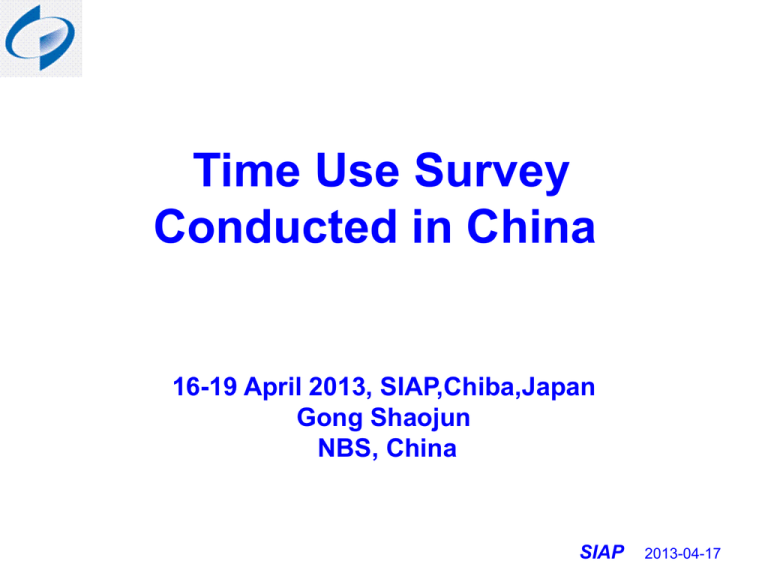
Time Use Survey Conducted in China 16-19 April 2013, SIAP,Chiba,Japan Gong Shaojun NBS, China SIAP 2013-04-17 Two aspects: Ⅰ. Survey Method Ⅱ. Main Results on TUS SIAP 2013-04-17 Ⅰ. Survey Method Type of data collection ○ Data collection instrument ○ Sample coverage ○ Classification of activities ○ Recording of contextual information ○ Recording of simultaneous activities ○ Coverage of relevant individual characteristics ○ Main challenges in data collection ○ SIAP 2013-04-17 ○ Type of data collection In May, 2008, Time Use Survey in China was organized by National Bureau of Statistics (NBS) and implemented by 10 Provincial Survey Organizations in China. The survey was an independent investigation. Its period was 7 days. SIAP 2013-04-17 ○ Data collection instrument We used the Diary Record and designed two diaries. a. weekday diary (5 days) b. weekend diary (2 days) The survey was conducted using a fixed interval diary. 10 minutes as one time interval in 24 hours a day. SIAP 2013-04-17 ○ Sample coverage selected 10 provinces : Beijing, Hebei, Heilongjiang, Zhejiang, Anhui, Henan, Guangdong, Sichuan, Yunnan, Gansu. 234 counties (include cities and districts in urban, township and rural). 18000 households. 45000 respondents aged 15 to 74 in the selected households. SIAP 2013-04-17 ○ Classification of activities Based on different nature of activities, all activities were classified into: - 9 main categories - 61 divisions - 113 groups SIAP 2013-04-17 ○ Classification of activities 9 main categories including: 0 - Individual activity 1 - Employment activity 2 - Household primary production activity 3 - Household manufacture and construction production activity 4 - Household service and business activity SIAP 2013-04-17 ○ Classification of activities 5 - Unpaid domestic work provided for oneself and family members 6 - Care for household members and provide unpaid help for others 7 - Study and training 8 - Recreation, leisure and social interaction SIAP 2013-04-17 ○ Recording of contextual information The respondents were required to record their activities in the diary. Activity consists of : • Primary activity (What) • Secondary activity • Place of activity (where) • Means of transportation (How) • With whom • And when the activity started. etc SIAP 2013-04-17 ○ Recording of simultaneous activities Definition was given for primary and secondary activities: The primary activity - refers to the only or the most important activity in several activities occurred at a specific time period simultaneously. The secondary activity - refers to the activity occurred simultaneously with the primary activity. SIAP 2013-04-17 ○ Coverage of relevant individual characteristics There was the questionnaire for the basic status of family member included mainly the following information: relation with head of household ● sex ● ethnicity ● education attainments ● marital status ● occupation ● SIAP 2013-04-17 ○ ● ● ● Main challenges in data collection How to design questionnaire Because Time Use Survey is a complicated work. A good questionnaire design is very important. It must be easy to understand and fill in. How to improve coordination degree Especially in urban, the problem is that residents don’t open the door for security. And poor attitude to the survey. The coordination degree is low. How to train enumerators and to make them understand the questionnaire better, etc. These challenges directly affect the data collection. SIAP 2013-04-17 Ⅱ. Main Results on TUS (1) - Through this survey we have got very valuable data to reflect the general status of average daily time use of all respondents, and also to reflect the gap of time use by gender and by area. - The most important thing is that we can use the data on TUS to analyze and measure paid work and unpaid domestic work. - Such as the statistical analysis report on General Time Use Structure in China and report on unpaid work and employment status using time use data, and so on. SIAP 2013-04-17 Ⅱ. Main Results on TUS (2) - Two publications on TUS in China were compiled after this survey. One is named as Time Use Patterns In China. It’s the first time to publish this kind of book in our bureau. - Introduced by my colleagues the experience about this survey many times in the international meeting. SIAP 2013-04-17 SIAP 2013-04-17 General time use structure in weekday This picture shows the data gap between men and women, and also between urban and rural in China. SIAP 2013-04-17 Average time use of non SNA-productive activities by weekday/weekend It’s clearly that food preparing time for women is longer than men both in weekday and weekend. SIAP 2013-04-17 Average time of Unpaid work by age and by gender This picture indicates women spend much more time than men on unpaid work. And cooking is main unpaid work. SIAP 2013-04-17 Participation rates of activities average per day Percent Percent 100 100 Paid work and study 80 Unpaid work Sleeping and other personal Watching TV 80 Meals 60 60 40 40 20 20 0 0 4 6 8 10 12 14 16 18 20 22 24 24 hour a day 2 4 Other leisure time 4 6 8 10 12 14 16 18 20 22 24 2 24 hours a day This graph indicates people’s life style and work/rest in 24 hours a day. For example, most of people in China begin to work or study at 8:00 am, and some people have the habit of sleeping after lunch time. SIAP 2013-04-17 4 Thank You ! SIAP 2013-04-17


